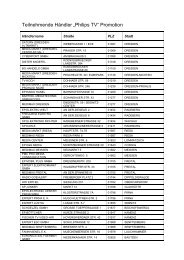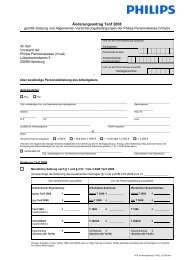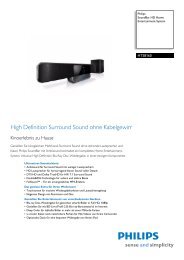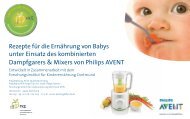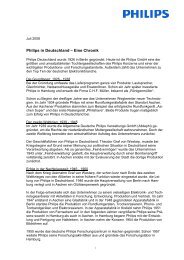Flying over Las Vegas - Philips
Flying over Las Vegas - Philips
Flying over Las Vegas - Philips
Create successful ePaper yourself
Turn your PDF publications into a flip-book with our unique Google optimized e-Paper software.
Environmental challenge<br />
The emergence of the entire environmental issue puts these lines of thought and areas of research<br />
into a broader perspective, linking them to a range of cultural, social and manufacturing problems.<br />
At the same time, it provides design culture with a remarkable opportunity. This is: to accept the<br />
limitations that the environment imposes on the current system of production and consumption,<br />
and to come up with a completely new set of solutions, based on new criteria for quality, indeed,<br />
for new qualities, which will stimulate.<br />
To develop relevant objects in this context, we also need some new design strategies.<br />
The best-known and most important of these include:<br />
Clean cycles<br />
The strategy of ‘clean cycles’ embraces the entire life-cycle of products - production, distribution,<br />
use and disposal. It includes an extensive range of interventions involving problems in the field of<br />
manufacturing (‘clean technology’), problems in the method of evaluation (‘eco-accounting’) and<br />
problems of certification (‘seals of environmental quality’).<br />
Assembly and disassembly<br />
The strategy of ‘assembly and disassembly’ is directed at the manufacture of products which, when<br />
they have reached the end of their useful life-cycle, can be dismantled and broken down into parts<br />
which can then be used in new cycles of production. This strategy requires that materials need to<br />
be carefully selected and designed so that complex products, whose components are made of different<br />
materials, can be easily broken down into homogeneous parts.<br />
Miniaturization<br />
The strategy of ‘miniaturization’ is aimed at the realization of relevant objects of environmental<br />
impact through a reduction in the amount of material and energy needed to obtain the desired results.<br />
The practicability of this strategy is closely linked to the availability of high-performance materials and<br />
technologies.<br />
Usability<br />
Today, the strategy of ‘usability’ focuses on the creation of relevant (i.e., highly usable) products which<br />
enhance people’s comfort, satisfaction, pleasure and productivity, with local responsiveness to (individual)<br />
cultures. This depends on the user-customer being involved in the product creation process.<br />
Service Carriers<br />
The strategy of products as ‘service carriers’, one of the most important trends in the modern system<br />
of manufacturing and consumption, entails the replacement of physical products with software products -<br />
in a word, services. What is important in the present context is the prospects they offer of providing<br />
information and services which directly result in reduced consumption of matter and energy. They are<br />
no longer products ‘for consumption’ but providers of services ‘for use’.<br />
Durability<br />
The goal of ‘durability’, the creation of relevant objects with lower environmental impact, can<br />
be pursued by either making objects which, though only moderately durable, are nonetheless highly<br />
recyclable; or we can extend the life-cycle of products, i.e., develop a generation of products which<br />
will continue to function for a very long time.<br />
14<br />
15



